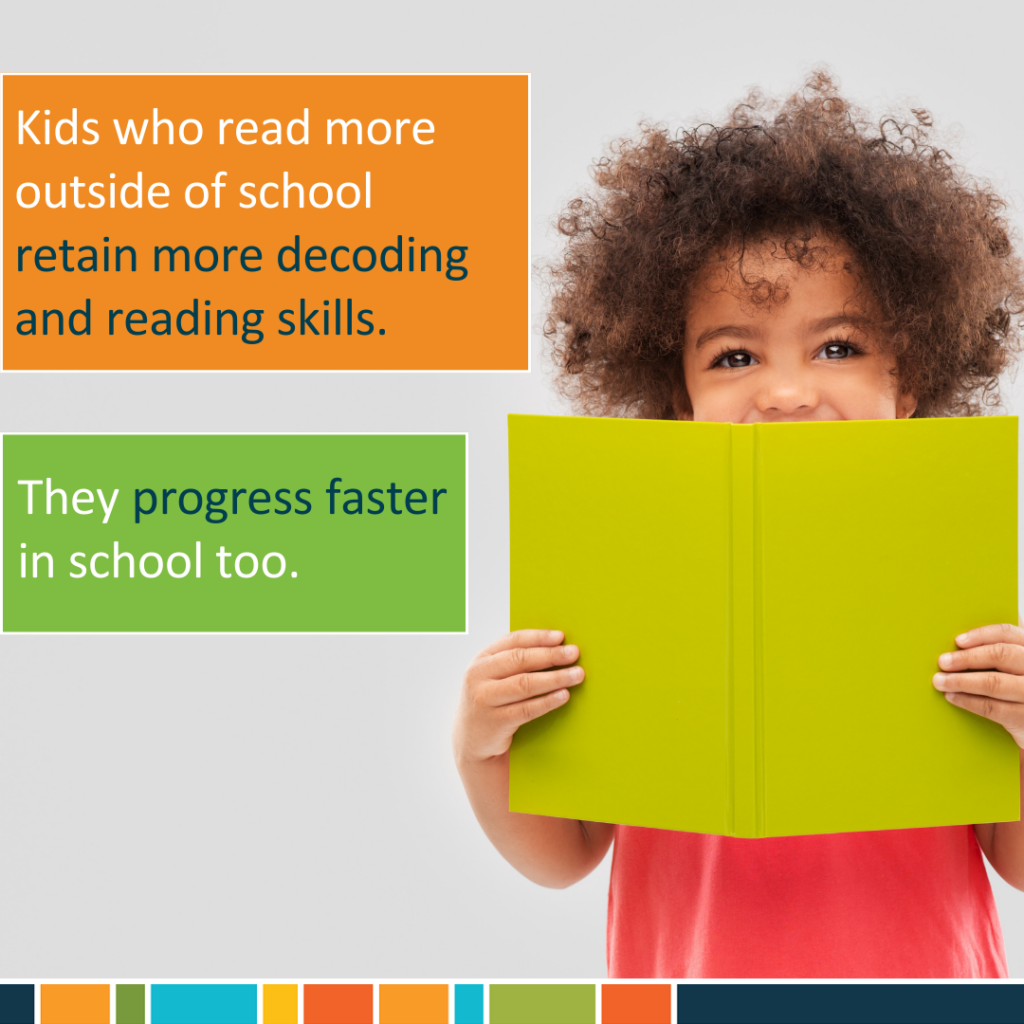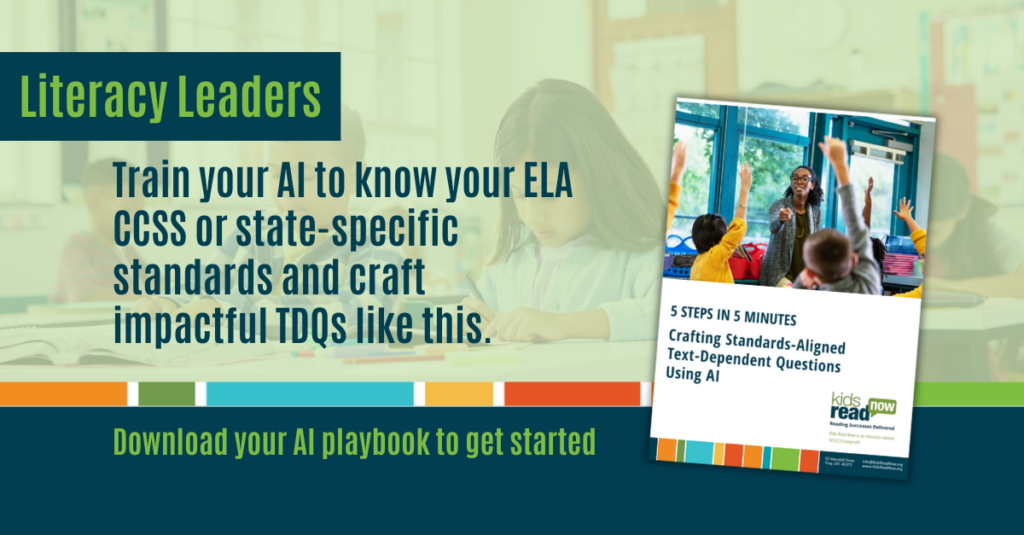Estimated reading time: 10 minutes
Let’s be honest — AI in education feels kind of overwhelming, right?
You’re not alone if you’re a bit uneasy or even skeptical about it. Many educators like you wonder if AI is really here to help or if it’s just another tech tool making things harder for teachers and more confusing for kids.
That’s why we’re excited to share insights from Ericka Macias-Esposito. She’s a member of the Kids Read Now Development Task Force and has been in the classroom just like you. Ericka’s seen how AI can actually make things easier — especially when it comes to creating text-dependent questions (TDQs).
In this article, Ericka breaks down how using AI for text-dependent questions can save you planning time so you can focus more on your students. She gets it — teachers need tools that actually help, not more things to figure out.
So whether you’re curious or cautious, take a minute to see how AI for TDQs could lighten your load and, most importantly, enhance your students’ learning along the way.
How AI for text-dependent questions can transform teaching and learning
In a time of swift technological advancements, artificial intelligence (AI) promises to significantly change various sectors, including education.
As an educator who has taught across different grade levels and content areas and in various educational contexts, I know that the idea of using AI to serve students was far-fetched just a few years ago. However, while there are still limitations with artificial intelligence, recent research shows that large language models like ChatGPT have grown tremendously as a tool utilized in and outside of schools and classrooms.
Worldwide, students are using AI to sift through research, write papers, and even engage in virtual tutoring.
And just like students who are using AI to engage in schoolwork differently than they have in the past, McKinsey 2020 reported that AI is supporting teachers in maximizing their instructional time. Further, AI facilitates educators’ focus on pedagogy and instructional practices by streamlining activities such as planning and assessment.
AI is transforming K-12 education the way we know it!
A solution for streamlining instruction
Research suggests that 20 to 40 percent of current teacher hours are spent on activities that could be automated using existing technology. This amount translates into approximately 13 hours per week that teachers could redirect toward activities that lead to higher student outcomes and higher teacher satisfaction.
In short, our research suggests that existing technology can help teachers reallocate 20 to 40 percent of their time to activities that support student learning.
To exploit this potential, Kids Read Now partnered with my company, Beyond the Resource. In our work together, we focused on leveraging tech to ensure teachers like you would save more time. Rather than spending hours creating tens of TDQs for every book, aligning those questions with student standards, and reflecting on the Science of Reading, you can use that precious time to internalize and plan your reading lessons.
In this article, you’ll see what we came up with for you!
What will you change this year to end the trend of PreK-5 reading loss?
If you’re ready to make a difference, augment your existing curriculum, and get your students practicing their reading outside of school time, then Kids Read Now is ready to help. Our supplemental, in-home, independent reading program is research-based and proven to work.
Reclaiming teacher time with AI for text-dependent questions
Our goal: strong, standards-aligned instruction that centers complex text and cognitively engages students from start to end. The team focused on one key aspect of PreK-5 ELA teaching and learning: text-dependent questions.
Across all state standards, students are expected to use evidence from texts to present careful analyses, well-defended claims, and clear information. A key method to help students develop these skills is using text-dependent questions — questions that can only be answered by referring back to the text.
However, selecting high-quality texts and writing TDQs — with an additional focus on the comprehension strand in Science of Reading — requires time, and often teachers’ preparation and planning time is simply too short to engage in this in-depth instructional front-loading.

The growing role of AI in K-12 classrooms
Beyond the Resource (BTR), a consultative practice that partners with district and school leaders, has been studying the effects of applying AI in the classroom compared to other high-yielding strategies.
Harnessing technology to support teachers with carrying out strong instruction and ensuring positive learning experiences for students seemed like the next step.
It was a wonderful surprise when, as a Kids Read Now (KRN) Development Task Force member, I collaborated with the team to do just that. We developed a resource that can save teachers much-needed time — time they can use instead to focus on internalizing their instruction and preparing for responsive, differentiated instruction.
Learn about it below, and don’t forget to download the free playbook!
5-Steps in 5 Minutes: Crafting Text-Dependent Questions Using AI
Leveraging our experience, expertise, and ChatGPT, our team conceived and developed a 5-step method for creating text-dependent questions aligned to ELA standards and the Science of Reading strands.
To provide implementation support, we developed an easy-to-use guide, “5 Steps in 5 Minutes: Crafting Text-Dependent Questions Using AI,” which includes sample outputs, allowing users to review the quality of results others have achieved and provide additional support for those new to using ChatGPT.
How AI for TDQs can improve literacy instruction
This guide will arm you, an elementary literacy leader and educator, with an easy-to-use playbook for using any AI (and, in our example, ChatGPT) to craft text-dependent questions.
If you’re an educator with limited experience working with an AI, you’ll find the step-by-step instructions, best practices, and practical tips will put you at ease.
If you are a familiar user of AI and ChatGPT, you can quickly move to the Prompt Recipe section, though we do recommend you scan through The ChatGPT Interface: A Walkthrough section for tips that might be new and useful to you.
The future of AI for text-dependent questions in K-12 education
We believe that the technology and guide will help teachers, school, and district leaders quickly develop an effective set of text-dependent questions to guide students to engage in analytical reading systematically.
The guidance will also build the capacity of teachers and school leaders to harness technology effectively for maximum gains, not only saving teacher time but also improving student outcomes.
Meet the Author

Follow Ericka and Beyond The Resource
Ericka Macias-Esposito is an experienced, passionate, and bilingual education advocate with a demonstrated history of championing and improving leadership, instruction, and a culture of learning within K-12, diverse, urban, and suburban school districts in New York and Georgia. She earned a BA in Early Childhood Education, Master’s in Literacy and Literacy Assessment, and Specialist Degree in Educational Leadership.
Ericka has dedicated 20+ years to building relationships, creating strong learning environments, leading PD, and coaching in service of improving instructional practices and student outcomes. To name a few, Ericka serves as:
- Founder and CEO of Beyond the Resource. Based in Atlanta, BTR is a consulting company that provides thought-partnership and innovative solutions for equitable outcomes for both educators and students.
- Partner of TNTP — nonprofit whose mission is to end injustice in public education through projects that provide students access to academic, social, and economic pathways.
- Leadership Georgia (LGA) alumna
- Caminar Latino Board member
- National Development Task Force member for Kids Read Now
Approaching AI with curiosity and an open mind
So, there you have it. AI for text-dependent questions doesn’t have to be intimidating. In fact, it can save you some of the precious time you need to focus on what really matters — your students. AI can take some of the planning pressure off your shoulders by helping you efficiently create high-quality, standards-aligned TDQs.
Of course, no tool is perfect, and AI is no exception. But when used thoughtfully, it can make a real difference in your school. And remember — it’s not about replacing teachers; it’s about supporting them in their work.
If you’re feeling a bit more curious about AI now, that’s great!
The key is to start small, try it out, and see how it works for you. You might find that it’s not as overwhelming as it seemed.
Who knows? It might even become one of your favorite tools for streamlining lessons and improving student outcomes.
So why not give it a shot? You’ve got this!
Frequently Asked Questions
AI for text-dependent questions refers to harnessing artificial intelligence, using a tool like ChatGPT, to help create questions that require students to reference specific texts for their answers. These questions align with educational standards and help students develop critical reading and comprehension skills.
A text-dependent question (TDQ) is a question that can only be answered by referring back to a specific text. TDQs encourage students to use evidence from the text to support their answers, fostering deeper reading comprehension and critical thinking.
AI for TDQs can save teachers time by streamlining the creation of high-quality, standards-aligned questions. This allows teachers to focus more on instruction and student engagement rather than spending extra hours on lesson planning.
AI for TDQs can be used to create questions that align with the Common Core, individual state standards, and the Science of Reading comprehension strands. This ensures that instruction with carefully-crafted text-dependent questions helps meet critical academic goals from PK-12. As students progress through grade levels, consider a taxonomy of questions, similar to Bloom’s revised taxonomy, that ranges from factual, conceptual, procedural, and metacognitive knowledge and understanding.
No way! AI is not meant to — and cannot — replace teachers. It is a tool that can assist teachers in creating TDQs more efficiently, allowing them to focus on instruction. Teachers still have full control over the content and quality of the questions generated by AI.





